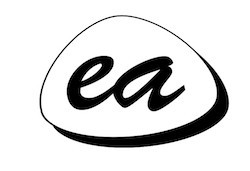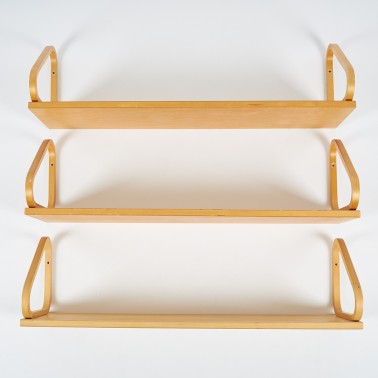List of products by brand Aalto Alvar
Alvar Aalto, one of Finland's most famous people who reshaped architecture and furniture of public buildings on the basis of functionality and organic relationship between man, nature and buildings, is now called the "Father of Modernism" in Scandinavian countries.
He was born Hugo Alvar Henrik Aalto, on February 3, 1898, in Kuortane, Finland (at that time Finland was part of Russian Empire). He was the first of three children. His father, J. H. Aalto, was a government surveyor. His mother, Selma Hackestedt, was of Swedish ancestry, she died in 1903. His father remarried and moved the family to the town of Jyvaskyla. There young Aalto attended the Normal School and the Classical Gymnasium, graduating in 1916. During the summer months, young Aalto accompanied his father on surveying trips. From 1916-1921 he studied at the Helsinki University of technology, graduating with a degree in architecture. While a student, Aalto worked for Carolus Lindberg on the design of the "Tivoli" area for the 1920 National Fair. At that time Aalto was a protégé of Armas Lingren, partner of E. Saarinen during the formative period of Finnish National architecture of Romanticism. Aalto served in the Finnish National Militia during the Civil War that followed after the Russian Revolution, when the nation of Finland gained independence from Russia.
In 1922-1923 Aalto worked for a project in Sweden, he collaborated with A. Bjerke on the design of the Congress Hall for the 1923 World Fair in Goteborg. He also designed several buildings for the 1922 Industrial fair in Tampere. In 1923 Aalto opened his first architectural office in Juvaskyla. In 1924 he married architect Aino Marsio, they had two children, Johanna (born 1925), and Hamilkar (born 1928). Aalto and his wife had their honeymoon in Italy. The Mediterranean culture made a profound influence on Aalto's creativity, it blended with his Nordic intellect and remained important to his visionary works for the rest of his life. The simple massing and ornamentation of the "architettura mirwire" of Northern Italy translated into Aalto's style with its balanced proportions, harmonious volumes rendered in stucco or wood, and sparse decoration with selective use of classical elements. In 1927 the Aaltos moved to the city of Turku. There, Alvar Aalto designed the Paimio Sanatorium, a building that elevated him to the status of master of heroic functionalism. He soon moved forward in his pursuit of artistic harmony through organic integration of people and buildings with the environment. Such was his design for the Villa Mairea (1938) in Noormarkku, one of the most admired private residences in contemporary architecture.
In 1933 Aalto moved to Helsinki. There he founded his architecture firm "Artek" where he executed his major international commissions, such as Finnish Pavilions for the 1936 Paris World Fair and the 1939-1940 New York's World Fair, libraries in Oregon, USA, and Finland, Opera House in Essen, Germany. His other significant buildings included Baker House at the Massachussetts Institute of Technology, Cambridge, Mass., USA, Central University Hospital in Zagreb, Croatia, Helsinki Institute of Technology, North Utland Art Museum in Denmark, Nordic House in Reykjavic, Iceland, Public Library in Vyborg, (now Russia), and many other buildings. His later masterpieces include the municipal building in Sayanasalo (1952), the Vuoksenniska Church (1959) and the Finlandia Hall in Helsinki. His works exhibit a range of innovative ideas presented with comforting clarity and carefully crafted balance of intricate and complex forms, spaces, and elements, that are integrated in a simple and well-proportioned way. Aalto's design for the Finnish Pavilion at the 1939 New York's World Fair was described as "work of genius" by Frank Lloyd Wright.
Functionalism and synthetic attitude were important in Aalto's evolution from Nordic Classicism towards Modernism. He created his own way of converging forms, materials, and purpose of his buildings on the rationale of their functionality, aesthetics, and comfortable use. Aalto's architecture, furniture, glassware and jewelery evokes multiple allusions to images of unspoiled nature, thus making an ennobling influence on public behavior. He designed 70 buildings for the town of Jyvaskyla, 37 of which were realized, such as the Institute of Pedagogy (1953-1957) and other public buildings. Aalto's ecological awareness was epitomized in his design of the Sunila Cellulose Industry and the residential village for employees (1936 - 1939) and its second stage (1951 - 1954). Aalto's creativity was deeply rooted in his own organic way of life, traditional for the people in Scandinavian countries. "The very essence of architecture consists of a variety and development reminiscent of natural organic life. This is the only true style in architecture" said Alvar Aalto.
Alvo Aalto was Chairman of the Arcitects Union and President of the Finnish Academy. His latest building for the Art Museum in Jyvaskyla was named after him. His awards included the Royal Gold Medal from the Royal Institute of British Architects (1957) and the Gold Medal from the American Institute of Architects (1963). Alvar Aalto was featured on the last series of the 50 Finnish mark bill, before the Euro. He died of natural causes on May 11, 1976, in Helsinki and was laid to rest in Hietaniemi Cemetery in Helsinki, Finland.

"I do not write, I build" - Alvar Aalto

